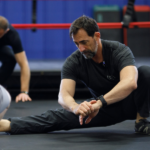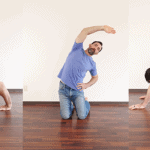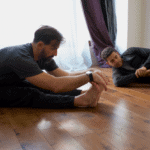Got that nagging ache in your back again? Or more just feeling creaky and stiff after working at your desk for a couple hours?
It’s okay. Most people do. That’s why there’s thousands of products out there saying they’ll fix you up!
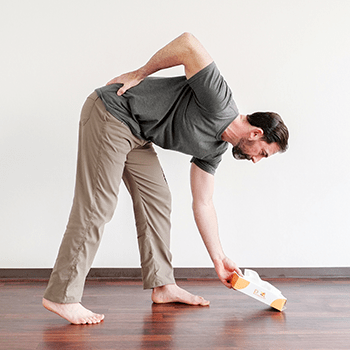 And when you look for exercises you can do to improve your condition, more often than not, you come across movements that are simply too much for you right now.
And when you look for exercises you can do to improve your condition, more often than not, you come across movements that are simply too much for you right now.
And it’s especially frustrating even when you are making the time to exercise and doing pretty good!
The hours at work at a desk, in meetings, or in the car build tension that’s hard to shake… and it adds up. So you shift around and twist and maybe get a few pops and cracks and feel better for a little bit. Sometimes it lasts longer but most of the time it doesn’t.
It’s easy to assume the ache and stiffness in your back is simply because it’s tight and the muscles have to be stretched out. But after 25+ years of working with patients and clients, I can tell you, it’s rarely that simple.
Before we dive in, I just want to remind you that the information in this article is no substitute for being seen by a professional in-person if you have ongoing issues–particularly related to pain or weakness.
Why it Feels So Tight (Even When You Stretch)
 Back pain or tightness, as common as it is, is not always well understood.
Back pain or tightness, as common as it is, is not always well understood.
Back pain and stiffness aren’t necessarily a sign that you have bodily damage, but it’s always a signal from your brain that there is something going on that it doesn’t like.
Sometimes, genetics or age can be factors in your back issues, although I’d caution you against letting those prevent you from working on improving your condition. (Click here for an article about why age doesn’t have to limit you).
What feels like tight muscles is your nervous system trying to protect you. It limits motion to prevent what it perceives as threat, especially when joints aren’t moving well together or past injuries have created compensation patterns.
Your brain reads all that and says:
“Let’s lock this down for now.”
You just want to move around and simply get comfortable. But your muscles feel so stiff and joints feel creaky. And it’s not really because you damaged anything, your nervous system has just decided that being tighter is better for you right now.
And you don’t fix that with more aggressive stretching. You change it by re-establishing communication with your body through controlled, comfortable, multi-directional motion.
This routine is built for that.
Daily Routine: Six Movements to Reclaim Comfort and Coordination
No single position will “fix” your back.
But these movements help restore essential actions your spine may not be getting enough of: extension, flexion, sidebending, rotation. And they do it in ways that adapt to where you are—not where some 22-year-old mobility coach thinks you should be.
Don’t get too caught up in doing the stretches exactly the way Jeff looks in the video. You may have less mobility (or more) than Jeff does for certain stretches, and that’s okay. Just follow the instructions to match your current abilities. You will improve over time.
Simple doesn’t mean too easy, it means it’s the start.
Let’s take a look at each of these back stretches in more detail.
1. Prone Extension
Reintroduce spinal extension with intention and support

- Lie prone (flat on your stomach). Forearms on the floor. Hands wherever you need them to feel supported (not jammed under your shoulders).
- Let your chest rise. Think length, not just height.
- Focus the movement through your thoracic spine—your mid and upper back—rather than hinging into your lumbar spine. Just move your hands slightly forward until you find a comfortable distance.
- If you are able to do this stretch with no problem, you can work on straightening your elbows to extend the back further. Eventually, you may end up with your hands directly beneath your shoulders and your elbows completely straight (but don’t rush into it!).
Move in and out of the stretch 10 times, then hold for 30-60 seconds. Repeat 3 times.
2. Wag Tail

A playful way to explore lateral motion—often neglected, always needed
- Start on hands and knees, with your knees together and past your hips.
- Lift your feet off of the ground and swing them to the right and then to the left.
- Keep your back flat throughout the movement, so that the motion is primarily a sidebending motion.
For this exercise, you won’t be doing any holds. Just do 10 reps per side.
3. Quadruped Sidebend

Targets the lateral chain: lats, QL, spinal erectors
- Start in kneeling, with your hands stretched in front of you. If you have tight quads that prevent you from getting into the deep kneeling position you see Jeff in, just go as far as you can go comfortably.
- Move your hands to one side so they are at a 45-degree angle (or more) to your body. You should feel a good stretch in this position.
Move in and out of the stretch 10 times, then hold for 30-60 seconds. Repeat 3 times, then switch to the opposite side.
4. Quadruped Torso Rotation
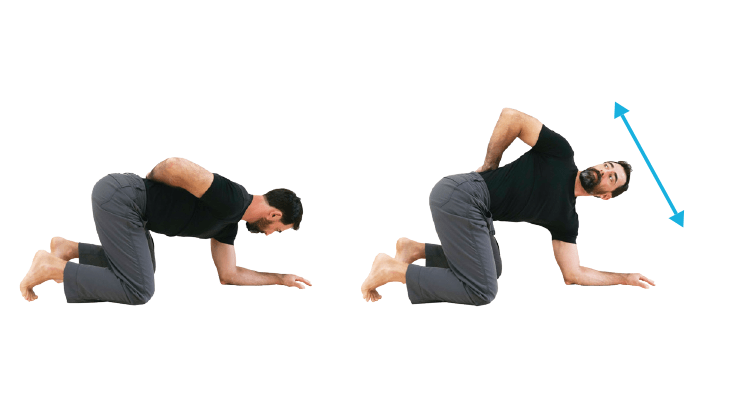
Restores segmental rotation—critical for everyday movement
- Start on your hands and knees, so that your elbows are directly beneath your shoulders and your knees directly beneath your hips.
- Then shift one forearm so that it is directly below the midline of your chest and place the other hand on your low back.
- Rotate your body toward that elbow, looking up toward the ceiling as you do. Press down into the ground with your supporting elbow to keep the rest of your body stable.
Move in and out of the stretch 10 times, then hold for 30-60 seconds. Repeat 3 times, then switch to the opposite side.
5. Half Pancake

A favorite exercise from our flexibility program because of the combination of sidebending + rotation + hip involvement, this one does a lot
- Sit with one leg extended, the other bent inward. Feel free to bend the knee on the outstretched leg to make this position more comfortable.
- Rotate your torso toward the bent knee, then reach up over your head toward the foot of the outstretched leg.
- Only go as deep as you can without feeling any painful discomfort.
For the half pancake, get into position and then hold for 30-60 seconds, then switch to the opposite side.
6. A-Frame to Squat
 Fluid transition between spinal flexion and extension, under changing load
Fluid transition between spinal flexion and extension, under changing load
- Start in an A-Frame position (also known as “downward facing dog” in yoga). This is where you will start on your hands and knees, and then push your butt up into the air, forming an “A” position. If you can’t straighten your legs all the way in this position, don’t worry. Focus on pushing through your hands so that you flatten out your back as much as possible.
- Walk your feet forward and drop down into a squat. Try to keep your hands on the ground if you can. If not, don’t worry too much. Just play with your weight distribution and don’t force anything that feels uncomfortable.
- Return to the A-Frame position.
Hold the A-Frame for 10 seconds, then transition into the squat and hold that for another 10 seconds. Repeat this 10 times.
Not a Quick Fix, But A Long Lasting Change
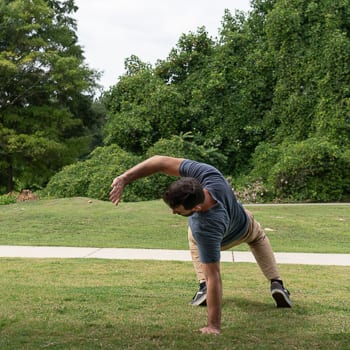 These movements won’t give you a new spine. But they can shift the tone of the conversation your body’s been having with itself.
These movements won’t give you a new spine. But they can shift the tone of the conversation your body’s been having with itself.
Instead of protect, guard, restrict, you may start to hear:
“Okay! We’re good here!”
That’s where change starts.
I know how hard that is–I’ve dealt with back pain myself–and I think you’ll find these daily back stretches to be helpful.
More often than not with patients experiencing restrictions in their backs, there are issues going on in other areas of the body as well. You may know this to be true from your own history.
Whatever the cause of your tight or achy back, the following routine will help you get better. For more information on causes of these issues, see our accompanying article on the spine, as well as this article on common myths about posture.
Your Back Moves Better When Everything Else Does Too
Nagging aches and stiffness in your back can feel like they show up for no reason. But most often, it’s not about your spine being the issue—it’s that your spine is doing more than its share.
When hips are stiff, shoulders are locked, and core coordination is off, the spine ends up compensating. That compensation might not be a problem in the short term, but over time, your back gets tired of holding it all together.
That’s why we see so many clients finally get relief when they stop chasing back pain directly—and instead train the whole system. With Elements, you don’t just work your back. You train all the moving parts around it to work better together.
Build a More Capable Back by Training the Whole Body
Elements gives you an efficient, full-body approach that improves your mobility, coordination, and resilience without hammering isolated joints or using aggressive drills. And if you’re dealing with serious stiffness or recovering from flare-ups, the Gradual Track lets you move gently and progressively while getting real results.




